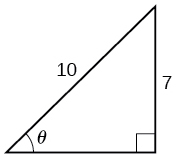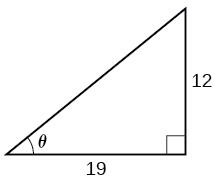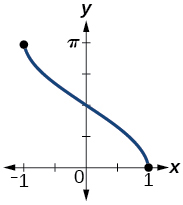7.4E: Exercises
( \newcommand{\kernel}{\mathrm{null}\,}\)
In this section, we will explore the inverse trigonometric functions. Inverse trigonometric functions “undoes” what the original trigonometric function “does,” as is the case with any other function and its inverse. In other words, the domain of the inverse function is the range of the original function, and vice versa.
Verbal
1) Why do the functions f(x)=\sin^{-1}x and g(x)=\cos^{-1}x have different ranges?
- Answer
-
The function y=\sin x is one-to-one on \left [ -\dfrac{\pi }{2},\dfrac{\pi }{2} \right ] thus, this interval is the range of the inverse function of y=\sin x, f(x)=\sin^{-1}x The function y=\cos x is one-to-one on [0,\pi ] thus, this interval is the range of the inverse function of y=\cos x, f(x)=\cos^{-1}x
2) Since the functions y=\cos x and y=\cos^{-1}x are inverse functions, why is \cos^{-1}\left (\cos \left (-\dfrac{\pi }{6} \right ) \right )not equal to -\dfrac{\pi }{6}?
3) Explain the meaning of \dfrac{\pi }{6}=\arcsin (0.5).
- Answer
-
\dfrac{\pi }{6} is the radian measure of an angle between -\dfrac{\pi }{2} and \dfrac{\pi }{2} whose sine is 0.5.
4) Most calculators do not have a key to evaluate \sec ^{-1}(2)Explain how this can be done using the cosine function or the inverse cosine function.
5) Why must the domain of the sine function, \sin xbe restricted to \left [ -\dfrac{\pi }{2},\dfrac{\pi }{2} \right ] for the inverse sine function to exist?
- Answer
-
In order for any function to have an inverse, the function must be one-to-one and must pass the horizontal line test. The regular sine function is not one-to-one unless its domain is restricted in some way. Mathematicians have agreed to restrict the sine function to the interval \left [ -\dfrac{\pi }{2},\dfrac{\pi }{2} \right ] so that it is one-to-one and possesses an inverse.
6) Discuss why this statement is incorrect: \arccos(\cos x)=x for all x.
7) Determine whether the following statement is true or false and explain your answer: \arccos(-x)=\pi - \arccos x
- Answer
-
True . The angle, \theta _1 that equals \arccos(-x), x>0, will be a second quadrant angle with reference angle, \theta _2, where \theta _2 equals \arccos x, x>0. Since \theta _2 is the reference angle for \theta _1, \theta _2=\pi - \theta _1 and \arccos(-x)=\pi - \arccos x-
Algebraic
For the exercises 8-16, evaluate the expressions.
8) \sin^{-1}\left(\dfrac{\sqrt{2}}{2}\right)
9) \sin^{-1}\left(-\dfrac{1}{2}\right)
- Answer
-
-\dfrac{\pi }{6}
10) \cos^{-1}\left(-\dfrac{1}{2}\right)
11) \cos^{-1}\left(-\dfrac{\sqrt{2}}{2}\right)
- Answer
-
\dfrac{3\pi }{4}
12) \tan^{-1}(1)
13) \tan^{-1}(-\sqrt{3})
- Answer
-
-\dfrac{\pi }{3}
14) \tan^{-1}(-1)
15) \tan^{-1}(\sqrt{3})
- Answer
-
\dfrac{\pi }{3}
16) \tan^{-1}\left(\dfrac{-1}{\sqrt{3}}\right)
For the exercises 17-21, use a calculator to evaluate each expression. Express answers to the nearest hundredth.
17) \cos^{-1}(-0.4)
- Answer
-
1.98
18) \arcsin (0.23)
19) \arccos \left(\dfrac{3}{5}\right)
- Answer
-
0.93
20) \cos^{-1}(-0.8)
21) \tan^{-1}(6)
- Answer
-
1.41
For the exercises 22-23, find the angle \theta in the given right triangle. Round answers to the nearest hundredth.
22)

23)

- Answer
-
0.56 radians
For the exercises 24-36, find the exact value, if possible, without a calculator. If it is not possible, explain why.
24) \sin^{-1}(\cos(\pi))
25) \tan^{-1}(\sin(\pi))
- Answer
-
0
26) \cos^{-1}\left(\sin \left(\dfrac{\pi}{3} \right)\right)
27) \tan^{-1}\left(\sin \left(\dfrac{\pi}{3} \right)\right)
- Answer
-
0.71
28) \sin^{-1}\left(\cos \left(\dfrac{-\pi}{2} \right)\right)
29) \tan^{-1}\left(\sin \left(\dfrac{4\pi}{3} \right)\right)
- Answer
-
-0.71
30) \sin^{-1}\left(\sin \left(\dfrac{5\pi}{6} \right)\right)
31) \tan^{-1}\left(\sin \left(\dfrac{-5\pi}{2} \right)\right)
- Answer
-
-\dfrac{\pi}{4}
32) \cos \left(\sin^{-1} \left(\dfrac{4}{5} \right)\right)
33) \sin \left(\cos^{-1} \left(\dfrac{3}{5} \right)\right)
- Answer
-
0.8
34) \sin \left(\tan^{-1} \left(\dfrac{4}{3} \right)\right)
35) \cos \left(\tan^{-1} \left(\dfrac{12}{5} \right)\right)
- Answer
-
\dfrac{5}{13}
36) \cos \left(\sin^{-1} \left(\dfrac{1}{2} \right)\right)
For exercises 37-41, find an algebraic expression in terms of x for the given trig expression, with the help of a reference right triangle.
37) \tan \left(\sin^{-1} (x-1)\right)
- Answer
-
\dfrac{x-1}{\sqrt{-x^2+2x}}
38) \sin \left(\sin^{-1} (1-x)\right)
39) \cos \left(\sin^{-1} \left(\dfrac{1}{x}\right)\right)
- Answer
-
\dfrac{\sqrt{x^2-1}}{x}
40) \cos \left(\tan^{-1} (3x-1)\right)
41) \tan \left(\sin^{-1} \left(x+\dfrac{1}{2}\right)\right)
- Answer
-
\dfrac{x+0.5}{\sqrt{-x^2-x+\tfrac{3}{4}}}
Extensions
For the exercise 42, evaluate the expression without using a calculator. Give the exact value.
42) \dfrac{\sin^{-1}\left ( \tfrac{1}{2} \right )-\cos^{-1}\left ( \tfrac{\sqrt{2}}{2} \right )+\sin^{-1}\left ( \tfrac{\sqrt{3}}{2} \right )-\cos^{-1}(1)}{\cos^{-1}\left ( \tfrac{\sqrt{3}}{2} \right )-\sin^{-1}\left ( \tfrac{\sqrt{2}}{2} \right )+\cos^{-1}\left ( \tfrac{1}{2} \right )-\sin^{-1}(0)}
For the exercises 43-47, find the function if
43) \cos t
- Answer
-
\dfrac{\sqrt{2x+1}}{x+1}
44) \sec t
45) \cot t
- Answer
-
\dfrac{\sqrt{2x+1}}{x}
46) \cos \left(\sin^{-1} \left(\dfrac{x}{x+1}\right)\right)
47) \tan^{-1} \left(\dfrac{x}{\sqrt{2x+1}}\right)
- Answer
-
t
Graphical
48) Graph y=\sin^{-1} x and state the domain and range of the function.
49) Graph y=\arccos x and state the domain and range of the function.
- Answer
-

domain [-1,1]range [0,\pi ]
50) Graph one cycle of y=\tan^{-1} x and state the domain and range of the function.
51) For what value of x does \sin x=\sin^{-1} x? Use a graphing calculator to approximate the answer.
- Answer
-
approximately x=0.00
52) For what value of x does \cos x=\cos^{-1} x? Use a graphing calculator to approximate the answer.
Real-World Applications
53) Suppose a 13-foot ladder is leaning against a building, reaching to the bottom of a second-floor window 12 feet above the ground. What angle, in radians, does the ladder make with the building?
- Answer
-
0.395 radians
54) Suppose you drive 0.6 miles on a road so that the vertical distance changes from 0 to 150 feet. What is the angle of elevation of the road?
55) An isosceles triangle has two congruent sides of length 9 inches. The remaining side has a length of 8 inches. Find the angle that a side of 9 inches makes with the 8-inch side.
- Answer
-
1.11 radians
56) Without using a calculator, approximate the value of \arctan (10,000)Explain why your answer is reasonable.
57) A truss for the roof of a house is constructed from two identical right triangles. Each has a base of 12 feet and height of 4 feet. Find the measure of the acute angle adjacent to the 4-foot side.
- Answer
-
1.25 radians
58) The line y=\dfrac{3}{5}x passes through the origin in the x,y-plane. What is the measure of the angle that the line makes with the positive x-axis?
59) The line y=\dfrac{-3}{7}x passes through the origin in the x,y-plane. What is the measure of the angle that the line makes with the negative x-axis?
- Answer
-
0.405 radians
60) What percentage grade should a road have if the angle of elevation of the road is 4 degrees? (The percentage grade is defined as the change in the altitude of the road over a 100-foot horizontal distance. For example a 5\% grade means that the road rises 5 feet for every 100 feet of horizontal distance.)
61) A 20-foot ladder leans up against the side of a building so that the foot of the ladder is 10 feet from the base of the building. If specifications call for the ladder's angle of elevation to be between 35 and 45 degrees, does the placement of this ladder satisfy safety specifications?
- Answer
-
No. The angle the ladder makes with the horizontal is 60 degrees.
62) Suppose a 15-foot ladder leans against the side of a house so that the angle of elevation of the ladder is 42 degrees. How far is the foot of the ladder from the side of the house?

